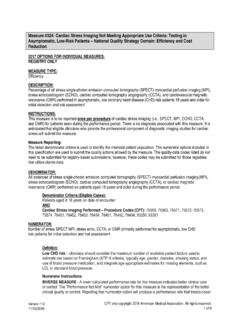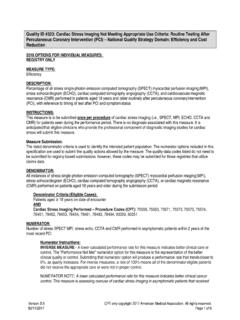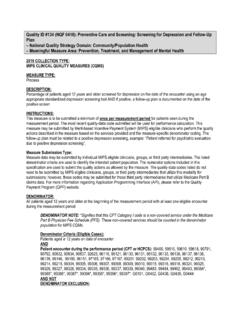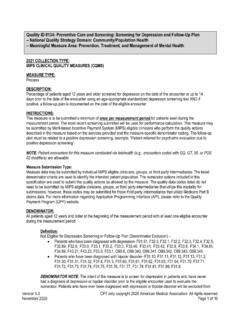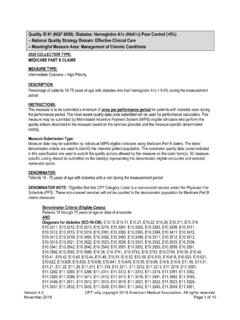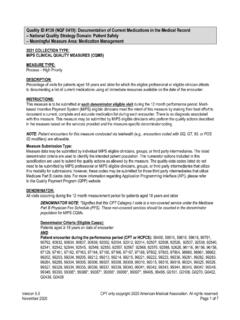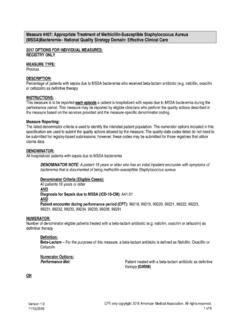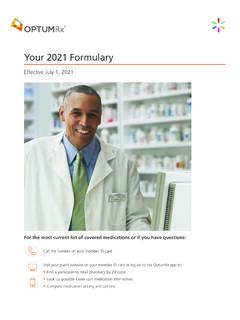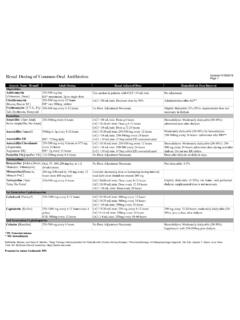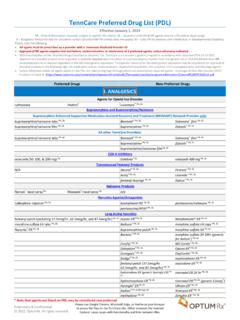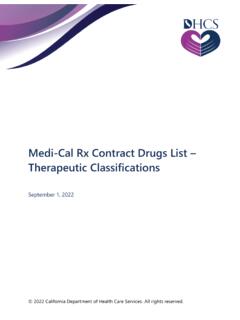Transcription of Quality ID #238 (NQF 0022): Use of High-Risk Medications ...
1 Quality ID #238 (NQF 0022): Use of High-Risk Medications in the Elderly National Quality Strategy Domain: Patient Safety Meaningful Measure Area: Medication Management 2020 COLLECTION TYPE: MIPS CLINICAL Quality MEASURES (CQMS). MEASURE TYPE: Process High Priority DESCRIPTION: Percentage of patients 65 years of age and older who were ordered High-Risk Medications . Two rates are submitted. 1) Percentage of patients who were ordered at least one High-Risk medication. 2) Percentage of patients who were ordered at least two of the same High-Risk Medications .
2 INSTRUCTIONS: This measure is to be submitted a minimum of once per performance period for patients seen during the performance period. There is no diagnosis associated with this measure. This measure may be submitted by Merit-based Incentive Payment System (MIPS) eligible clinicians who perform the Quality actions described in the measure based on the services provided and the measure-specific denominator coding. This measure will be calculated with 2 performance rates: 1) Percentage of patients who were ordered at least one High-Risk medication 2) Percentage of patients who were ordered at least two of the same High-Risk Medications MIPS eligible clinicians should continue to submit the measure as specified, with no additional steps needed to account for multiple performance rates.
3 Measure Submission Type: Measure data may be submitted by individual MIPS eligible clinicians, groups, or third party intermediaries. The listed denominator criteria are used to identify the intended patient population. The numerator options included in this specification are used to submit the Quality actions as allowed by the measure. The Quality -data codes listed do not need to be submitted by MIPS eligible clinicians, groups, or third party intermediaries that utilize this modality for submissions; however, these codes may be submitted for those third party intermediaries that utilize Medicare Part B.
4 Claims data. For more information regarding Application Programming Interface (API), please refer to the Quality Payment Program (QPP) website. THERE ARE TWO SUBMISSION CRITERIA FOR THIS MEASURE: 1) Percentage of patients who were ordered at least one High-Risk medication OR. 2) Percentage of patients who were ordered at least two of the same High-Risk Medications SUBMISSION CRITERIA 1: PERCENTAGE OF PATIENTS WHO WERE ORDERED AT LEAST ONE High-Risk . MEDICATION. DENOMINATOR (SUBMISSION CRITERIA 1): Patients 65 years and older who had a visit during the measurement period Version CPT only copyright 2019 American Medical Association.
5 All rights reserved. November 2019 Page 1 of 14. Denominator Criteria (Eligible Cases) 1: Patients aged 65 years on date of encounter AND. Patient encounter during performance period (CPT or HCPCS): 99201, 99202, 99203, 99204, 99205, 99212, 99213, 99214, 99215, 99341, 99342, 99343, 99344, 99345, 99347, 99348, 99349, 99350, G0438, G0439. AND NOT. DENOMINATOR EXCLUSION: Patients who use hospice services any time during the measurement period: G9741. NUMERATOR (SUBMISSION CRITERIA 1): Patients with an order for at least one High-Risk medication during the measurement period Definitions: The intent of Numerator 1 is to assess if the patient has been prescribed at least one High-Risk medication.
6 Cumulative Medication Duration - an individual's total number of medication days over a specific period;. the period counts multiple prescriptions with gaps in between, but does not count the gaps during which a medication was not dispensed. To determine the cumulative medication duration, determine first the number of the Medication Days for each prescription in the period: the number of doses divided by the dose frequency per day. Then add the Medication Days for each prescription without counting any days between the prescriptions. Table 1 High-Risk Medications at any dose or duration Description Prescription Brompheniramine Dimenhydrinate Carbinoxamine Diphenhydramine (oral).
7 Chlorpheniramine Doxylamine Anticholinergics, first-generation antihistamines Clemastine Hydroxyzine Cyproheptadine Meclizine Dexbrompheniramine Promethazine Dexchlorpheniramine Triprolidine Anticholinergics, anti-Parkinson agents Benztropine (oral) Trihexyphenidyl Atropine (exclude ophthalmic). Belladonna alkaloids Hyoscyamine Antispasmodics Clidinium- Propantheline chloradiazepoxide Scopolamine Dicyclomide Dipyridamole, oral short-acting (does not Antithrombotics Ticlopidine apply to the combination with aspirin). Cardiovascular, alpha agonists, central Methyldopa Guanfacine Nifedipine, immediate Cardiovascular, other Disopyramide release Version CPT only copyright 2019 American Medical Association.
8 All rights reserved. November 2019 Page 2 of 14. Description Prescription Central nervous system, antidepressants Amitriptyline Imipramine Clomipramine Trimipramine Amoxapine Nortriptyline Desipramine Paroxetine Protriptyline Central nervous system, barbiturates Amobarbital Pentobarbital Butabarbital Phenobarbital Butalbital Secobarbital Central nervous system, vasodilators Ergot mesylates Isoxsuprine Central nervous system, other Meprobamate Endocrine system, estrogens with or without progestins; Conjugated estrogen Estradiol include only oral and topical patch products Estropipate Esterified estrogen Endocrine system, sulfonylureas, long- duration Chlorpropamide Glyburide Endocrine system, other Desiccated thyroid Megestrol Pain Medications , skeletal muscle relaxants Carisoprodol Metaxalone Chlorzoxazone Methocarbamol Cyclobenzaprine Orphenadrine Pain Medications , other Indomethacin Ketorolac.
9 Includes Meperidine parenteral Pentazocine Table 2 - High-Risk Medications With Days Supply Criteria Description Prescription Days Supply Criteria Anti-Infectives, nitrofurantoin nitrofurantoin >90 days other nitrofurantoin macrocrystals- macrocrystals monohydrate Nonbenzodiazepine Eszopiclone Zolpidem >90 days hypnotics Zaleplon NUMERATOR NOTE: Some High-Risk Medications are not included in this specific measure but should be avoided above a specified average daily dose. These Medications are listed in Table 3. To calculate an average daily dose multiply the quantity of pills ordered by the dose of each pill and divide by the days supply.
10 For example, a prescription for a 30-days supply of digoxin containing 15 pills, mg each pill, has an average daily dose of mg. Version CPT only copyright 2019 American Medical Association. All rights reserved. November 2019 Page 3 of 14. Table 3 - High-Risk Medications With Average Daily Dose Criteria Description Prescription Average Daily Dose Criteria Alpha agonists, central Reserpine > mg/day Cardiovascular, other Digoxin > mg/day Tertiary TCAs (as single agent or as part of Doxepin >6 mg/day combination products). Numerator Instructions: INVERSE MEASURE - A lower calculated performance rate for this measure indicates better clinical care or control.
